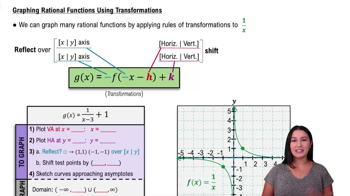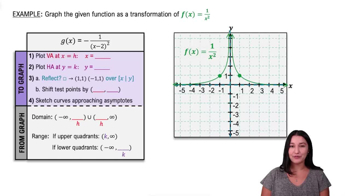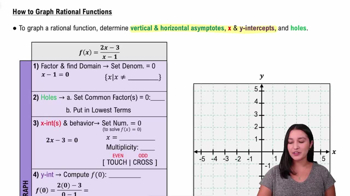Table of contents
- 0. Review of Algebra4h 16m
- 1. Equations & Inequalities3h 18m
- 2. Graphs of Equations43m
- 3. Functions2h 17m
- 4. Polynomial Functions1h 44m
- 5. Rational Functions1h 23m
- 6. Exponential & Logarithmic Functions2h 28m
- 7. Systems of Equations & Matrices4h 6m
- 8. Conic Sections2h 23m
- 9. Sequences, Series, & Induction1h 19m
- 10. Combinatorics & Probability1h 45m
5. Rational Functions
Graphing Rational Functions
Problem 59b
Textbook Question
Identify any vertical, horizontal, or oblique asymptotes in the graph of y=ƒ(x). State the domain of ƒ. 
 Verified step by step guidance
Verified step by step guidance1
Identify the vertical asymptote by finding the value of x where the function approaches infinity or negative infinity. In this graph, the vertical asymptote is at x = -2.
Identify the horizontal asymptote by observing the behavior of the function as x approaches positive or negative infinity. In this graph, there is no horizontal asymptote.
Identify the oblique asymptote by observing the slant of the function as x approaches positive or negative infinity. In this graph, the oblique asymptote is the line y = x.
State the domain of the function by identifying all x-values for which the function is defined. The function is undefined at x = -2, so the domain is all real numbers except x = -2.
Summarize the findings: The vertical asymptote is at x = -2, there is no horizontal asymptote, the oblique asymptote is y = x, and the domain is all real numbers except x = -2.
Recommended similar problem, with video answer:
 Verified Solution
Verified SolutionThis video solution was recommended by our tutors as helpful for the problem above
Video duration:
7mPlay a video:
Was this helpful?
Key Concepts
Here are the essential concepts you must grasp in order to answer the question correctly.
Asymptotes
Asymptotes are lines that a graph approaches but never touches. Vertical asymptotes occur where a function approaches infinity or negative infinity as the input approaches a certain value, indicating a discontinuity. Horizontal asymptotes describe the behavior of a function as the input approaches infinity, showing the value the function approaches. Oblique (or slant) asymptotes occur when the degree of the numerator is one higher than that of the denominator in a rational function.
Recommended video:

Introduction to Asymptotes
Domain of a Function
The domain of a function is the complete set of possible values of the independent variable (usually x) for which the function is defined. It includes all real numbers except those that cause the function to be undefined, such as values that lead to division by zero or square roots of negative numbers. Understanding the domain is crucial for identifying vertical asymptotes and ensuring the function's behavior is accurately represented.
Recommended video:

Domain Restrictions of Composed Functions
Graph Behavior at Infinity
Graph behavior at infinity refers to how a function behaves as the input values grow larger or smaller without bound. This concept is essential for identifying horizontal and oblique asymptotes, as it helps determine the end behavior of the graph. Analyzing limits as x approaches positive or negative infinity allows us to predict the function's long-term trends and understand its overall shape.
Recommended video:

Identifying Intervals of Unknown Behavior

 5:31m
5:31mWatch next
Master Graphing Rational Functions Using Transformations with a bite sized video explanation from Callie
Start learningRelated Videos
Related Practice




